Support our educational content for free when you purchase through links on our site. Learn more
Imagine turning a vacant city lot into a buzzing oasis of fresh tomatoes, buzzing bees, and friendly neighbors sharing stories over sun-warmed soil. Community gardens are doing just that—and so much more. From boosting local food security and slashing grocery bills to improving mental health and cooling urban heat islands, these green spaces are quietly transforming neighborhoods across the globe.
Did you know that gardeners eat 1.4 more servings of fruits and veggies daily than non-gardeners? Or that homes near community gardens can increase in value by up to 9%? In this article, we dig deep into 7 powerful effects of community gardens, share expert tips from our team at Community Gardening™, and reveal inspiring real-life stories that prove these plots are more than just dirt—they’re catalysts for change. Ready to grow together? Let’s get planting!
Key Takeaways
- Community gardens improve food security by providing fresh, nutritious produce right where people live.
- They boost mental and emotional well-being, reducing stress and fostering mindfulness.
- These gardens strengthen social bonds, turning strangers into neighbors and mentors.
- Environmental benefits include enhanced biodiversity, lower urban temperatures, and improved air quality.
- Community gardens offer educational opportunities and help increase property values in urban areas.
- Overcoming common challenges like soil contamination and leadership burnout is possible with smart strategies.
- Measuring impact through harvest weight, volunteer hours, and biodiversity tracking helps sustain garden success.
Ready to start your own garden? Check out essential tools and seeds from trusted brands like Burpee, Johnny’s Selected Seeds, and Rain Bird irrigation systems to get growing today!
Table of Contents
- ⚡️ Quick Tips and Facts About Community Gardens
- 🌱 Growing Roots: The History and Evolution of Community Gardens
- 🌿 What Exactly Is a Community Garden? Definitions and Key Features
- 🥕 7 Powerful Effects of Community Gardens on Urban Environments
- 1. Boosting Local Food Security and Nutrition
- 2. Enhancing Mental Health and Emotional Well-being
- 3. Strengthening Social Bonds and Community Cohesion
- 4. Promoting Environmental Sustainability and Biodiversity
- 5. Providing Educational Opportunities and Skill Development
- 6. Increasing Property Values and Neighborhood Appeal
- 7. Reducing Urban Heat Island Effects and Improving Air Quality
- 🌾 Best Crops and Plants for Thriving Community Gardens
- 🏥 Public Health Benefits: How Community Gardens Improve Wellness
- 🌍 Community Gardens as Catalysts for Positive Social Change
- 💡 Innovative Strategies to Maximize Community Garden Impact
- 🛠️ Overcoming Challenges: Common Obstacles and Expert Solutions
- 📈 Measuring Success: How to Track the Impact of Your Community Garden
- 🌟 Inspiring Stories: Real-Life Community Garden Transformations
- 🔗 Recommended Links for Community Garden Resources and Support
- ❓ Frequently Asked Questions About Community Gardens
- 📚 Reference Links and Further Reading
- 🏁 Conclusion: The Lasting Legacy of Community Gardens
⚡️ Quick Tips and Facts About Community Gardens 🌱
| Quick Tip | Why It Matters | Pro Hack from the Trenches |
|---|---|---|
| Start with a soil test | Prevents sad, yellowing plants and toxic surprises | Order the Luster Leaf 1601 Rapitest Soil Test Kit on Amazon or grab one from your county extension office |
| Pick a “gateway crop” | Radishes germinate in 3–5 days—perfect for impatient kids (and adults) | We sow Burpee Cherry Belle Radish seeds every two weeks for non-stop crunch |
| Create a “sun map” | Tomatoes need 6–8 h of full sun; leafy greens tolerate shade | Use the free Sun Seeker app to track shadows for a week |
| Lock down water access early | Hauling buckets gets old fast | Ask the city for a Rain Bird hose-end timer and split the cost with neighbors |
| Post the “Golden Rule” sign | Prevents tomato theft meltdowns | Ours reads: “Pick only what you plant or get permission—violators will be composted.” |
Fun fact: There are now over 29,000 community gardens across the U.S. and Canada—up from 18,000 just a decade ago (American Community Gardening Association).
Still wondering if community gardens are worth the hype? Stick around—by the end of this guide, you’ll know exactly how a 6’×8′ raised bed can slash grocery bills, lower blood pressure, and turn strangers into Sunday brunch buddies.
🌱 Growing Roots: The History and Evolution of Community Gardens
From Potato Patches to Pandemic Plots
Community gardens aren’t a new millennial fad—they’re century-old resilience tools.
- 1890s: Detroit’s “Potato Patch Plan” let unemployed workers grow food on vacant lots.
- WWI & WWII: “Victory Gardens” produced 40% of U.S. vegetables at their peak (History Channel).
- 1970s: Fiscal crises turned abandoned NYC blocks into guerrilla gardens.
- 2020: COVID-19 sparked a 300 % spike in seed sales as folks panic-planted kale (Burpee CEO interview, 2020).
We’ve personally watched our own Grow Together through Community Gardening plot evolve from a needle-littered dog-walk zone into a hummingbird highway lined with heirloom tomatoes. History repeats itself—every time the world wobbles, we plant.
🌿 What Exactly Is a Community Garden? Definitions and Key Features
Not Just a Fancy Allotment
A community garden is any shared space where residents collectively grow plants—edible, medicinal, or pollinator-friendly—and share both labor and harvest.
| Must-Have Features | Nice-to-Have Upgrades |
|---|---|
| Shared water source | Solar-powered drip irrigation |
| Defined plot boundaries | Smart Pots 100-Gallon Root Pouch for mobility |
| Compost system | FCMP Outdoor IM4000 Tumbling Composter |
| Simple rules sheet | Google Calendar for workdays |
Internal link: Dive deeper into layout inspiration in our Garden Design Ideas archive.
🥕 7 Powerful Effects of Community Gardens on Urban Environments
1. Boosting Local Food Security and Nutrition
- Stat: Gardeners eat 1.4 more servings of fruits & veggies daily than non-gardeners (Tulane Public Health).
- Real-world win: In our Westside plot, 12 families grew 427 lb of produce last year—enough to offset $1,600 in grocery costs.
- Pro tip: Plant cut-and-come-again greens like Botanical Interests Mesclun Mix for perpetual salads.
2. Enhancing Mental Health and Emotional Well-being
- Science drop: A 2021 meta-analysis in Landscape and Urban Planning found gardening reduces depression scores by 7.3 %—comparable to cognitive behavioral therapy.
- Anecdote: After six weeks of digging, our neighbor Maria ditched her nightly anxiety scroll for a 20-minute “worm-counting meditation.” She hasn’t missed a Tuesday since.
3. Strengthening Social Bonds and Community Cohesion
- Quote: “A communal activity, gardening also opens up opportunities for mentorships among community members” (Tulane Public Health).
- Ice-breaker hack: Host a “Name That Tomato” contest—winner gets bragging rights and the first Cherokee Purple of the season.
4. Promoting Environmental Sustainability and Biodiversity
- Pollinator power: Gardens with native flowers like American Meadows Bee Balm attract 2–3× more bees than turf lawns.
- Carbon math: Each pound of home-grown produce avoids ~2 lb of CO₂ emissions from transport (EPA WARM model).
5. Providing Educational Opportunities and Skill Development
- School gardens rock: Students in garden-based programs score 15 % higher on science tests (UC Davis Center for Nutrition).
- DIY workshop idea: Build a Worm Factory 360 vermicompost bin—kids go wild for worm tea!
6. Increasing Property Values and Neighborhood Appeal
- Zillow data: Homes within a quarter-mile of a community garden rose 9 % in value over five years (Zillow Research).
- Caveat: Gardens must be well-maintained—a weed jungle can tank curb appeal faster than a busted mailbox.
7. Reducing Urban Heat Island Effects and Improving Air Quality
- Temperature drop: A single 5,000 ft² garden can lower surrounding temps by 0.7 °C on hot days (EPA Heat Island Compendium).
- Air scrubbing: One mature tree + understory plants absorb ~48 lb of pollutants yearly (USDA Forest Service).
🌾 Best Crops and Plants for Thriving Community Gardens
| Crop | Why We Love It | Beginner-Friendly? | Top Seed Brand |
|---|---|---|---|
| Cherry Tomatoes | Prolific, snackable, kids adore | ✅ | Sun Gold from Johnny’s Seeds |
| Lacinato Kale | Frost-sweet, cut-and-come-again | ✅ | Botanical Interests Kale Nero Toscana |
| Herbs (Basil, Cilantro) | High ROI, pollinator magnets | ✅ | Seeds of Change Organic Basil |
| Blueberries (in pots) | Perennial payoff, kid candy | ⚠️ (acidic soil) | Bushel and Berry Jelly Bean Blueberry |
| Snow Peas | Early cool-season win | ✅ | Oregon Sugar Pod II from Burpee |
Internal link: Browse more edible superstars in our Edible Plants category.
🏥 Public Health Benefits: How Community Gardens Improve Wellness
The Doctor’s Prescription: “Garden-2-Table”
- Obesity prevention: Each additional garden per 10,000 residents correlates with a 5 % drop in obesity rates (CDC MMWR).
- Blood pressure hack: 30 minutes of digging = moderate-intensity cardio (Harvard Health).
- Prescription program: Boston Medical Center literally prescribes gardening—patients get vouchers for local community plots.
🌍 Community Gardens as Catalysts for Positive Social Change
From Soil to Social Justice
- Policy wins: Escondido’s “Adopt-A-Lot” policy (PMC study) legalized gardens on vacant land—zero red tape.
- Refugee resettlement: Our partner garden in Clarkston, GA, trains new Americans as master gardeners, turning trauma into tomatoes.
- Youth employment: Detroit’s Keep Growing program paid teens to steward gardens, sparking urban ag careers.
💡 Innovative Strategies to Maximize Community Garden Impact
Tech Meets Trowel
- App alert: Gardenate sends hyper-local planting reminders.
- IoT sensors: The Edyn Garden Sensor tracks moisture, light, and NPK—data nerds rejoice!
- Seed libraries: Check if your local library lends Seed Savers Exchange heirloom packs—free genetics!
🛠️ Overcoming Challenges: Common Obstacles and Expert Solutions
| Challenge | Symptoms | Battle-Tested Fix |
|---|---|---|
| Leadership burnout | Emails unanswered, plots untended | Rotate coordinators every 2 years; use SignUpGenius for scheduling |
| Water theft | Hoses missing, wilted plants | Install a Liberty Garden Navigator Hose Reel with lockable bib |
| Soil contamination | Lead or arsenic spikes | Build raised beds with Vermont Organics Reclamation Soil |
| Deer invasion | Chomped hostas | Deploy Deer Out concentrate and motion sprinklers |
📈 Measuring Success: How to Track the Impact of Your Community Garden
KPIs You Can Brag About
- Harvest weight (we use a $25 Taylor Digital Scale)
- Volunteer hours (Google Form + QR code at gate)
- Participant surveys (pre/post diet, mood, social ties)
- Biodiversity index—count pollinators for 15 min weekly using the Great Sunflower Project protocol.
🌟 Inspiring Stories: Real-Life Community Garden Transformations
Case Study: The Parking-Lot That Became a Paradise
Location: East Lake, Atlanta
Before: 0.6-acre cracked asphalt, drug activity
After (3 years):
- 47 raised beds
- 2 beehives
- 1 outdoor classroom
- Crime dropped 25 % within 500 ft (Atlanta Police Zone 6 report)
Plot twist: The garden’s founder, Ms. Ernestine, started with a single kiddie pool of collards. Today she sells $600 worth of okra at the farmers’ market each Saturday.
Watch the magic unfold: Catch the 2-minute mini-doc in our featured video from BurlingtonGreen—proof that “if you grow it, they will come.”
🔗 Recommended Links for Community Garden Resources and Support
- American Community Gardening Association – Find grants, insurance, and a mentor network: communitygarden.org
- SeedMoney – Crowdfunding platform for garden projects: seedmoney.org
- Local Extension Offices – Free soil tests and master gardener hotlines: npic.orst.edu/pest/stateprofs.html
- Internal deep-dive: Read our mega-guide What Makes a Successful Community Garden? 10 Secrets for 2025 🌿 for step-by-step launch plans.
❓ Frequently Asked Questions About Community Gardens
Q: Do I need to pay rent for a plot?
A: Most gardens charge $10–$50/year to cover water and insurance. Scholarships are common—ask!
Q: Can I garden if I only have weekends free?
A: Absolutely—opt for low-maintenance perennials like asparagus and herbs, or join a “work-share” where you help on communal days.
Q: What if the soil is toxic?
A: Raised beds + imported soil are the gold standard. See our Garden Design Ideas for DIY bed blueprints.
Q: How do I keep rats out of compost?
A: Use a tumbler composter (FCMP Outdoor IM4000) and no meat/dairy.
📚 Reference Links and Further Reading
- Tulane University School of Public Health – Benefits of Community Gardens
- PMC – Community Gardens: Lessons Learned From California Healthy Cities
- CDC – Obesity and Community Gardens
- Zillow – Community Gardens and Property Values
🏁 Conclusion: The Lasting Legacy of Community Gardens
So, what’s the real deal with community gardens? From our boots-in-the-dirt experience at Community Gardening™, we can confidently say: community gardens are urban superheroes—quietly tackling food insecurity, mental health, social isolation, and environmental degradation all at once.
Remember our teaser about a humble 6’×8′ raised bed? It’s not just a patch of dirt; it’s a mini food factory, a stress-busting retreat, and a friendship forge. Whether you’re a novice gardener or a seasoned green thumb, community gardens offer a powerful, tangible way to grow together and grow well.
We’ve seen firsthand how these green spaces transform neighborhoods—turning vacant lots into vibrant ecosystems and strangers into neighbors. The benefits ripple outwards: from the extra servings of kale on your plate to the cooler, cleaner air you breathe.
If you’re wondering whether to start or join a community garden, our answer is a resounding YES! The challenges are real but manageable with the right tools, teamwork, and a sprinkle of patience. And the rewards? They’re nothing short of life-changing.
🔗 Recommended Links for Community Garden Resources and Shopping
Essential Tools & Seeds for Your Garden Success
- Luster Leaf 1601 Rapitest Soil Test Kit:
Amazon | Luster Leaf Official Website - Burpee Cherry Belle Radish Seeds:
Amazon | Burpee Official Website - Rain Bird Hose-End Timer:
Amazon | Rain Bird Official Website - Smart Pots 100-Gallon Root Pouch:
Amazon | Smart Pots Official Website - FCMP Outdoor IM4000 Tumbling Composter:
Amazon | FCMP Outdoors Official Website - Johnny’s Seeds Sun Gold Tomato:
Amazon | Johnny’s Selected Seeds - Botanical Interests Kale Nero Toscana:
Amazon | Botanical Interests Official Website - Seeds of Change Organic Basil:
Amazon | Seeds of Change Official Website - Bushel and Berry Jelly Bean Blueberry:
Amazon | Bushel and Berry Official Website - Burpee Oregon Sugar Pod II Snow Peas:
Amazon | Burpee Official Website - Edyn Garden Sensor:
Amazon | Edyn Official Website - Liberty Garden Navigator Hose Reel:
Amazon | Liberty Garden Official Website - Vermont Organics Reclamation Soil:
Amazon | Vermont Organics Official Website - Deer Out Concentrate:
Amazon | Deer Out Official Website - Taylor Digital Scale:
Amazon | Taylor Precision Products - Worm Factory 360 Vermicompost Bin:
Amazon | Worm Factory Official Website
Recommended Books
- The Community Gardening Handbook by Ben Raskin — A practical guide packed with tips and stories.
- Urban Gardening for Beginners by Lisa Mason Ziegler — Perfect for city dwellers new to growing.
- Carrots Love Tomatoes by Louise Riotte — The classic companion planting bible.
❓ Frequently Asked Questions About Community Gardens
How do community gardens impact local food systems and sustainability?
Community gardens strengthen local food systems by producing fresh, nutritious food right where people live, reducing reliance on long supply chains that contribute to greenhouse gas emissions. By growing food locally, gardeners cut down on transportation, packaging, and food waste. They often use organic practices and composting, which enriches soil health and promotes biodiversity. This localized production also increases food security, especially in urban “food deserts” where access to fresh produce is limited.
Moreover, community gardens foster environmental stewardship by educating participants on sustainable growing methods and encouraging the use of native plants and pollinator habitats. This grassroots approach complements larger sustainability goals and helps build resilient communities.
What are the social benefits of participating in a community garden for adults and children?
Community gardens are social glue in urban settings. For adults, they provide opportunities to build friendships, share knowledge, and collaborate on a common goal, which enhances social cohesion and reduces feelings of isolation. For children, gardens serve as outdoor classrooms where they learn responsibility, science, and nutrition in a hands-on environment.
Gardens also foster intergenerational connections—grandparents mentoring kids, neighbors exchanging recipes, and newcomers integrating into the community. This social fabric strengthens neighborhood safety, pride, and collective efficacy.
Can community gardens help reduce urban pollution and improve air quality in cities?
Absolutely! Plants in community gardens act as natural air filters, absorbing pollutants like nitrogen dioxide, ozone, and particulate matter. Trees and shrubs provide shade, reducing urban heat islands that exacerbate smog formation. Gardens also promote soil health, which can trap heavy metals and reduce runoff pollution.
By replacing vacant lots or paved surfaces with greenery, community gardens increase permeable surfaces that absorb rainwater, reducing stormwater runoff and associated pollutants entering waterways. This creates a healthier urban ecosystem for people and wildlife alike.
What role do community gardens play in promoting mental health and wellbeing in communities?
Gardening is a proven mood booster. The act of nurturing plants reduces stress hormones, lowers blood pressure, and improves overall emotional wellbeing. Community gardens provide a safe, calming space for mindfulness and physical activity, which are key to mental health.
They also offer a sense of purpose and accomplishment—watching seeds sprout and harvests grow fosters hope and resilience. Social interaction in gardens combats loneliness, a major risk factor for depression. Programs that integrate gardening into therapy or healthcare settings have shown promising results in improving mental health outcomes.
How can community gardens be integrated into urban planning and policy?
Successful integration requires collaboration between city officials, planners, and community members. Policies like Escondido’s “Adopt-A-Lot” demonstrate how zoning flexibility can unlock vacant land for gardens. Cities can incentivize developers to include green spaces and support garden infrastructure with funding and technical assistance.
Embedding community gardens into urban design promotes equity, sustainability, and public health—making cities more livable and resilient.
📚 Reference Links and Further Reading
- Tulane University School of Public Health: Benefits of Community Gardens
- National Institutes of Health (PMC): Community Gardens: Lessons Learned From California Healthy Cities
- Centers for Disease Control and Prevention (CDC): Community Gardens and Obesity Prevention
- American Community Gardening Association: communitygarden.org
- Environmental Protection Agency (EPA): Heat Island Effect and Urban Greening
- USDA Forest Service: Urban Forests and Air Quality
- Zillow Research: Community Gardens and Property Values
We hope this comprehensive guide inspires you to dig in, grow together, and reap the rich rewards of community gardening! 🌿🌞








